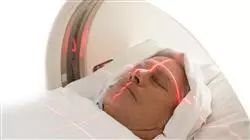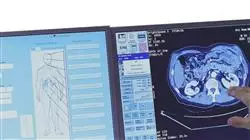University certificate
The world's largest faculty of engineering”
Introduction to the Program
A university program that will provide you with solid learning about physics and its direct application in the healthcare field. Take the step and sign up now"

Undoubtedly, technological advances have made it possible to transfer the knowledge and concepts of physics to reality. The contribution of engineering, in this sense, has been key to the current availability of devices that, in the healthcare field, facilitate the prevention, detection and treatment of certain diseases.
Therefore, significant progress has been made in radiation treatments (radiography, tomography, gammagraphy), equipment or the design of the facilities to be able to apply these therapies. Likewise, scientific groups have managed to go beyond a hospital center, to promote the modeling and development of vaccines or the creation of new drugs. Undoubtedly, the contribution of engineering professionals is a determining factor in achieving progress in this field. For this reason, TECH has designed this 100% online program, where the student will be able to obtain a solid learning about Medical Physics.
To this end, this academic institution provides the most innovative pedagogical tools. Thanks to them, students will be able to learn in a much more dynamic way about biophysics, the key concepts of optics or advanced thermodynamics. In addition, through a theoretical-practical approach, the professional will learn about remote sensing and image processing, the most commonly used computer programs and modern physics.
A university education taught exclusively online, without classes with fixed schedules and which the professional can access whenever and wherever they wish. All you need is an electronic device (computer, tablet or cell phone) with Internet connection to view all the syllabus on the Virtual Campus. In addition, students have the freedom to distribute the teaching load according to their needs. This program is, therefore, an excellent opportunity to progress professionally in Medical Physics through a Masters Degree, which is at the academic forefront.
Enroll now in a100% online Masters Degree that allows you to combine your professional responsibilities with a quality education"
This Masters Degree in Medical Physics contains the most complete and up-to-date program on the market. The most important features include:
- Practical case studies are presented by experts in Physics
- The graphic, schematic, and practical contents with which they are created, provide scientific and practical information on the disciplines that are essential for professional practice
- Practical exercises where the self-assessment process can be carried out to improve learning
- Its special emphasis on innovative methodologies
- Theoretical lessons, questions to the expert, debate forums on controversial topics, and individual reflection assignments
- Content that is accessible from any fixed or portable device with an Internet connection
Do you want to be the next engineering professional innovating in the field of Medical Physics? With this Masters Degree, you will gain the knowledge you need. Enroll now”
The program’s teaching staff includes professionals from the sector who contribute their work experience to this educational program, as well as renowned specialists from leading societies and prestigious universities.
The multimedia content, developed with the latest educational technology, will provide the professional with situated and contextual learning, i.e., a simulated environment that will provide immersive education programmed to learn in real situations.
This program is designed around Problem-Based Learning, whereby the professional must try to solve the different professional practice situations that arise during the academic year For this purpose, the student will be assisted by an innovative interactive video system created by renowned and experienced experts.
You have video summaries of each topic, videos in detail or essential readings with which you can acquire the most advanced knowledge in Medical Physics"

Delve into the physical processes in daily life and medical applications whenever you wish via your computer or tablet"
Why study at TECH?
TECH is the world’s largest online university. With an impressive catalog of more than 14,000 university programs available in 11 languages, it is positioned as a leader in employability, with a 99% job placement rate. In addition, it relies on an enormous faculty of more than 6,000 professors of the highest international renown.

Study at the world's largest online university and guarantee your professional success. The future starts at TECH”
The world’s best online university according to FORBES
The prestigious Forbes magazine, specialized in business and finance, has highlighted TECH as “the world's best online university” This is what they have recently stated in an article in their digital edition in which they echo the success story of this institution, “thanks to the academic offer it provides, the selection of its teaching staff, and an innovative learning method aimed at educating the professionals of the future”
A revolutionary study method, a cutting-edge faculty and a practical focus: the key to TECH's success.
The most complete study plans on the university scene
TECH offers the most complete study plans on the university scene, with syllabuses that cover fundamental concepts and, at the same time, the main scientific advances in their specific scientific areas. In addition, these programs are continuously being updated to guarantee students the academic vanguard and the most in-demand professional skills. In this way, the university's qualifications provide its graduates with a significant advantage to propel their careers to success.
TECH offers the most comprehensive and intensive study plans on the current university scene.
A world-class teaching staff
TECH's teaching staff is made up of more than 6,000 professors with the highest international recognition. Professors, researchers and top executives of multinational companies, including Isaiah Covington, performance coach of the Boston Celtics; Magda Romanska, principal investigator at Harvard MetaLAB; Ignacio Wistumba, chairman of the department of translational molecular pathology at MD Anderson Cancer Center; and D.W. Pine, creative director of TIME magazine, among others.
Internationally renowned experts, specialized in different branches of Health, Technology, Communication and Business, form part of the TECH faculty.
A unique learning method
TECH is the first university to use Relearning in all its programs. It is the best online learning methodology, accredited with international teaching quality certifications, provided by prestigious educational agencies. In addition, this disruptive educational model is complemented with the “Case Method”, thereby setting up a unique online teaching strategy. Innovative teaching resources are also implemented, including detailed videos, infographics and interactive summaries.
TECH combines Relearning and the Case Method in all its university programs to guarantee excellent theoretical and practical learning, studying whenever and wherever you want.
The world's largest online university
TECH is the world’s largest online university. We are the largest educational institution, with the best and widest online educational catalog, one hundred percent online and covering the vast majority of areas of knowledge. We offer a large selection of our own degrees and accredited online undergraduate and postgraduate degrees. In total, more than 14,000 university degrees, in eleven different languages, make us the largest educational largest in the world.
TECH has the world's most extensive catalog of academic and official programs, available in more than 11 languages.
Google Premier Partner
The American technology giant has awarded TECH the Google Google Premier Partner badge. This award, which is only available to 3% of the world's companies, highlights the efficient, flexible and tailored experience that this university provides to students. The recognition as a Google Premier Partner not only accredits the maximum rigor, performance and investment in TECH's digital infrastructures, but also places this university as one of the world's leading technology companies.
Google has positioned TECH in the top 3% of the world's most important technology companies by awarding it its Google Premier Partner badge.
The official online university of the NBA
TECH is the official online university of the NBA. Thanks to our agreement with the biggest league in basketball, we offer our students exclusive university programs, as well as a wide variety of educational resources focused on the business of the league and other areas of the sports industry. Each program is made up of a uniquely designed syllabus and features exceptional guest hosts: professionals with a distinguished sports background who will offer their expertise on the most relevant topics.
TECH has been selected by the NBA, the world's top basketball league, as its official online university.
The top-rated university by its students
Students have positioned TECH as the world's top-rated university on the main review websites, with a highest rating of 4.9 out of 5, obtained from more than 1,000 reviews. These results consolidate TECH as the benchmark university institution at an international level, reflecting the excellence and positive impact of its educational model.” reflecting the excellence and positive impact of its educational model.”
TECH is the world’s top-rated university by its students.
Leaders in employability
TECH has managed to become the leading university in employability. 99% of its students obtain jobs in the academic field they have studied, within one year of completing any of the university's programs. A similar number achieve immediate career enhancement. All this thanks to a study methodology that bases its effectiveness on the acquisition of practical skills, which are absolutely necessary for professional development.
99% of TECH graduates find a job within a year of completing their studies.
Master's Degree in Medical Physics
The implementation of state-of-the-art technologies has become essential for the proper functioning and evaluation of medical techniques and procedures. However, the development of these technological advances requires multidisciplinary experts capable of applying their knowledge to the prevention, detection, and treatment of various conditions and diseases. At TECH Global University, we have designed the Master’s Degree in Medical Physics — a specialized program that will enable you to deepen your understanding of the most advanced concepts, principles, and techniques in physics and apply them effectively within the fields of healthcare and medical research.
Specialize with the world’s largest School of Engineering
If you wish to apply your technical and scientific knowledge of physics to contribute to the medical field by developing devices that enhance the diagnosis, management, and treatment of diseases, this program is ideal for you. Through a rigorous and practice-oriented curriculum, guided by a team of experts and supported by the most comprehensive and up-to-date content, you will master the fundamental principles of physics applied to medicine. You will study the physical properties of living systems and develop the ability to analyze and apply critical reasoning to the interaction between physical and medical processes—particularly in radiotherapy, radiological risk assessment and control, and the processing of radiological and nuclear medicine images. This master’s degree offers a solid foundation in physics and its medical applications, equipping you with the tools to excel in both research and clinical environments. If you are ready to advance your career and stand out through excellence in this interdisciplinary field, enroll today and take the next step toward becoming a leader in medical physics.







